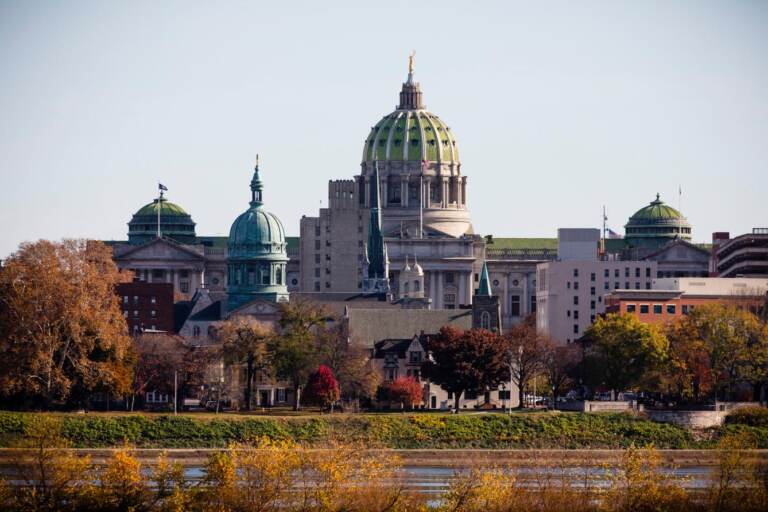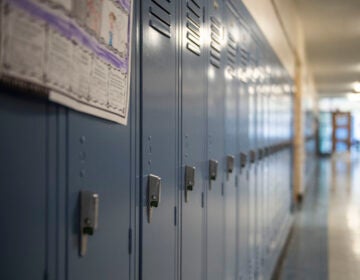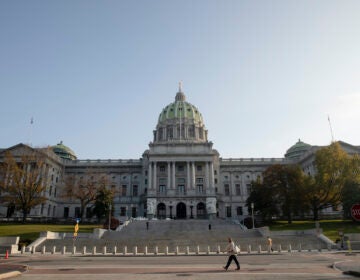Pennsylvania lawmakers pass nearly $48B budget almost 2 weeks late
The legislation falls well short of the $6.2 billion increase phased in over five years sought for underfunded schools by the districts that sued and won in court.

The Pennsylvania State Capitol building in Harrisburg, seen on Election Day 2022. (Amanda Berg/Spotlight PA)
Pennsylvania lawmakers ground through a flurry of votes Thursday to approve a budget deal, nearly two weeks into the new fiscal year after being slowed by disagreements during closed-door negotiations over Democrats’ push for more public schools aid.
The $47.6 billion plan for the fiscal year that started July 1 represents a 6% increase over last year’s approved spending, with most of the new money going toward public schools and human services to boost pay for direct care workers.
The plan also devotes more money to making college more affordable in a state that’s rated as among the worst in the nation in affordability and hundreds of millions to compete for huge new projects like multibillion-dollar microchip plants.
Votes in the Republican-controlled Senate and Democratic-controlled House began within hours of rank-and-file lawmakers getting their first look at hundreds of pages of budget-related legislation that first became public Thursday.
Democratic Gov. Josh Shapiro signed the main spending bill late Thursday night after it passed the House 122-80 and the Senate 44-5. Republican opponents attacked it as a bloated and irresponsible budget that would boost debt and spend down surpluses in an aging state facing projections of year-over-year deficits.
House Appropriations Committee Chairman Jordan Harris, D-Philadelphia, said the budget reflects a strong moral compass.
“This budget makes one of the most historic investments in what is our most valuable resources, and that is our children,” Harris said.
The plan doesn’t increase sales or income tax rates, the state’s two major revenue sources, although the package carries tax cuts for businesses to deduct more losses and students to deduct loan interest.
It will require about $3 billion of surplus cash to balance, leaving about $10.5 billion in reserve. Shapiro had initially proposed a $48.3 billion plan.
For public schools, the legislation delivers about $900 million more for instruction and special education, about a 9% increase, plus hundreds of millions more in new subsidies for school construction and tuition to private and cyber charter schools.
A substantial portion of the aid, about $526 million, is designed to represent a first step in responding to a court decision that found the state’s system of school funding violates the constitutional rights of students in poorer districts.
For weeks, a behind-the-scenes struggle played out between Republicans and Democrats over how to distribute the money. Senate Majority Leader Joe Pittman, R-Indiana, called the education funding formula “justifiable” and “accountable,” although one critic, Sen. Lindsey Williams, D-Allegheny, said it had been bent by “political whims.”
In any case, the legislation falls well short of the $6.2 billion increase phased in over five years sought for underfunded schools by the districts that sued and won in court. It is also smaller than the $870 million Democrats had pursued as the first step of a seven-year, $5.1 billion increase.
For higher education, the plan devotes an additional $260 million, or about 13% more, with most of the increase headed to the state-owned university system and to the Pennsylvania Higher Education Assistance Agency to expand grants to students.
Making college more affordable was a focus of Shapiro’s and Republican lawmakers in recent months. Still, the plan gives no increase in aid to Temple University, the University of Pittsburgh and Pennsylvania State University to subsidize in-state tuition.
On the human services side, a priority of Shapiro’s, ending a waiting list of thousands of families who need help for an intellectually disabled adult relative, will get an additional $228 million, or 10% more, as the first step in a multiyear plan. That is about half the amount that advocates say is needed to fix a system beset by staffing shortages, low pay and a thousands-long waiting list.
Nursing home operators will get a 7% increase, or $120 million, amid warnings that inadequate Medicaid reimbursements are forcing a growing number of homes to close. Counties will see a $20 million increase for mental health services, far short of the $250 million they had sought for a system they call crumbling and broken.
Shapiro, meanwhile, had sought about $280 million more for public transit systems — about 20% more — that are still struggling to recover ridership from the pandemic. Instead, Republicans agreed to about $80 million.
On economic development, Shapiro has vowed to compete with other states that are pouring billions into subsidies to attract microchip fabrication plants, electric vehicle battery plants and other huge projects. He proposed borrowing $500 million to get large plots of land ready. Lawmakers agreed to borrow $500 million, including $100 million for roads, water and sewer extensions.

Get daily updates from WHYY News!
WHYY is your source for fact-based, in-depth journalism and information. As a nonprofit organization, we rely on financial support from readers like you. Please give today.




